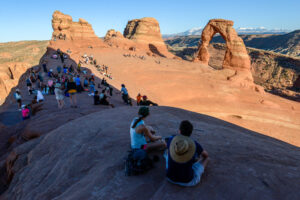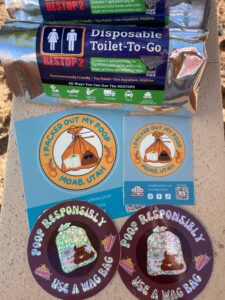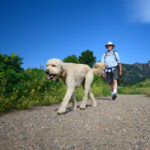Finding solutions for human waste in the backcountry
By Kristen Pope
Among stunning red arches, balancing rocks, canyons, pinyon-juniper, and cacti, a hiker in southern Utah sees something white in the distance. Is it a wildflower? Approaching the “blossom,” the hiker instead finds something far less picturesque—used toilet paper and human feces. No one wants to come across such a scene when they’re out enjoying public lands, but as visitors flock to the outdoors, this scenario plays out frequently. Human feces in the backcountry are unsightly, gross, and unsanitary—they can contaminate water, stick to pets and outdoor gear, and sicken people and animals. While this may have been a lesser issue in the past, now as millions of outdoor recreators visit the Moab area each year, land managers and user groups are pressed to find solutions.
“A lot of people feel as though they’re in the middle of nowhere,” says Jennifer Jones, assistant field manager for the Bureau of Land Management’s Moab Field Office. “They don’t understand that there are 3 million other folks that are going to be enjoying the same scenery and trails that they are, so tucking used toilet paper under a rock may seem like an innocent step, but unfortunately, with so many people doing that [and leaving] these little toilet paper blossoms all over the place, that becomes an issue for sure.”

In many parts of the country, burying fecal matter in a “cathole” is preferred, but in southern Utah’s arid environment, human waste and toilet paper doesn’t rapidly decompose. Grand County, Utah—home to Moab along with Arches and part of Canyonlands National Parks—has made leaving “solid human body waste” behind illegal. Instead, visitors must use a portable toilet, waste disposal bag, or other sanitary method to bring their poop out of the backcountry.
To overcome the “ick” factor and normalize this important sanitary measure, Grand County and partners held a “Poop Awareness Month” in October 2022. A social media campaign featured an inflatable poop emoji that, in short videos, explored the area, demonstrating responsible and irresponsible practices. Further, Grand County’s “Poop in Moab” website provides a handy guide for visitors, including requirements and best practices, while the statewide Gotta Go Utah campaign shares a similar message. BLM and other partners also produced a series of short films about responsible visitation in Moab’s fragile ecosystem. And the state’s OHV test includes questions about packing out human waste.
Agencies aren’t the only ones tackling this issue—the BASE jump and high line communities worked with the BLM to distribute over 2,000 specialized waste disposal bags and raise funds to build new vault toilets in high use areas for their sports.

Another important piece of the puzzle is communicating what people must do with the bags once they return to the trailhead. While some communities accept used human waste disposal bags with regular trash, in Moab, garbage trucks compact trash. “We had several incidents of our staff, because we have compactor trucks, getting sprayed with human waste when it compacted and these bags blew up,” says Jessica Thacker, program manager for Canyonlands Solid Waste Authority. These workers then needed a series of shots and medical check-ups, as well as new clothing.
Grand County, SE Utah Health Department, and others collaborated to install five special bins that can safely accept the used poop bags. QR codes on bags and at retail locations share the bin locations. During a pilot run from June through early October 2022, the disposal stations collected an estimated 1,200 pounds of human waste. “That’s 1,200 pounds that we didn’t risk going onto our staff or going into the local environment. It didn’t go into the waterways, so all the better for that,” Thacker says.
Problems with human waste are not limited to Utah. In Colorado’s Maroon Bells-Snowmass Wilderness, a permitting system is helping manage visitors and the unsanitary messes some leave behind. “By getting a permit, we’re engaging [visitors] with a lot more information ahead of time that can then set them up for success being in the backcountry, including how they are going to take care of their human waste,” says Katy Nelson, wilderness and trails program manager for the Aspen-Sopris Ranger District in the White River National Forest.
While using a bag is not required, each year the forest service and partners distribute around 5,000 free bags at three trailheads. In 2017, rangers recorded 334 incidents of unburied human waste in the wilderness area; in 2021 human waste incidents dropped to 153, and it’s likely the new permit system, messaging, and bag distribution played a role.
Human waste isn’t a new issue in the backcountry, but with increasing outdoor recreation, solutions are even more important. As communities across the West advance their outdoor recreation economies, they might look to places like Moab and the Maroon Bells for how to address this unpleasant reality.
Kristen Pope is a freelance writer who lives in the Tetons. Find more of her work at kepope.com.


